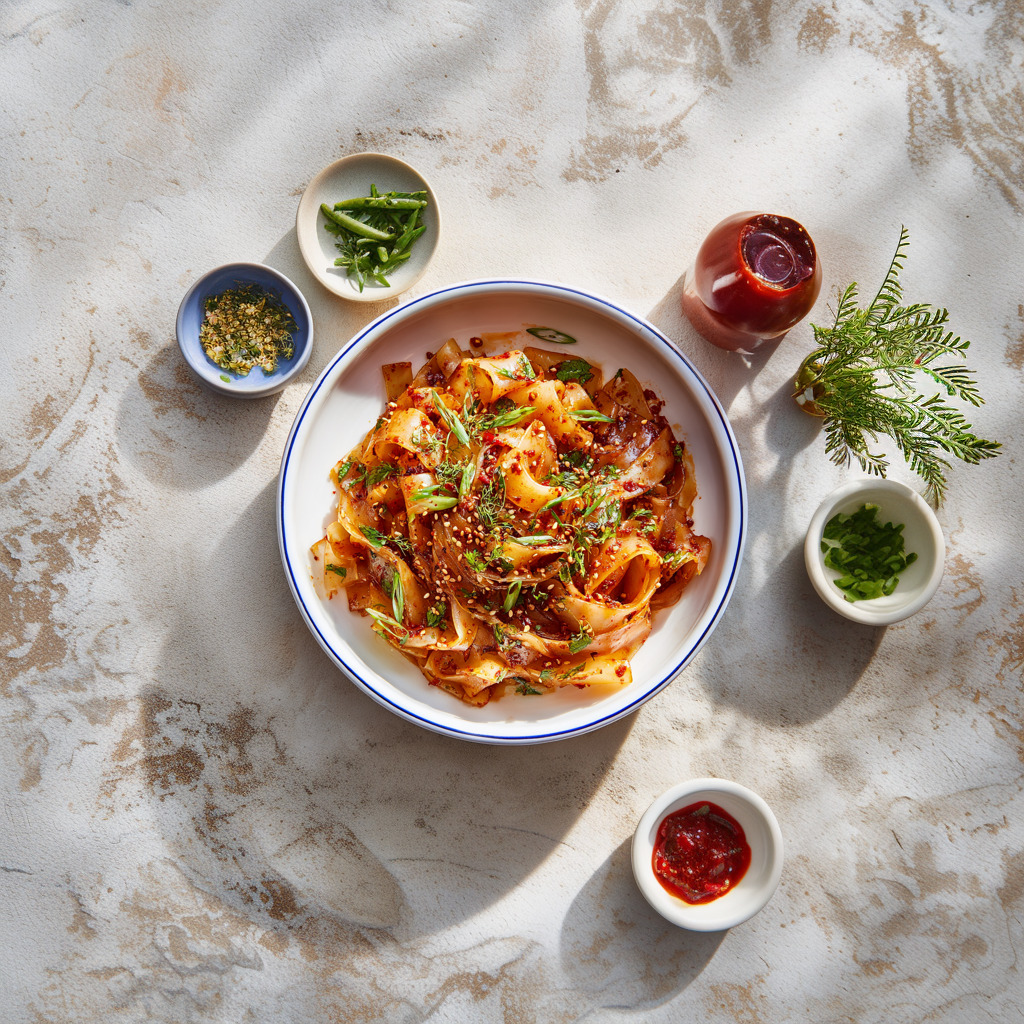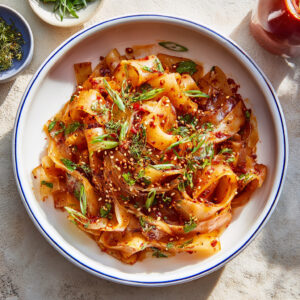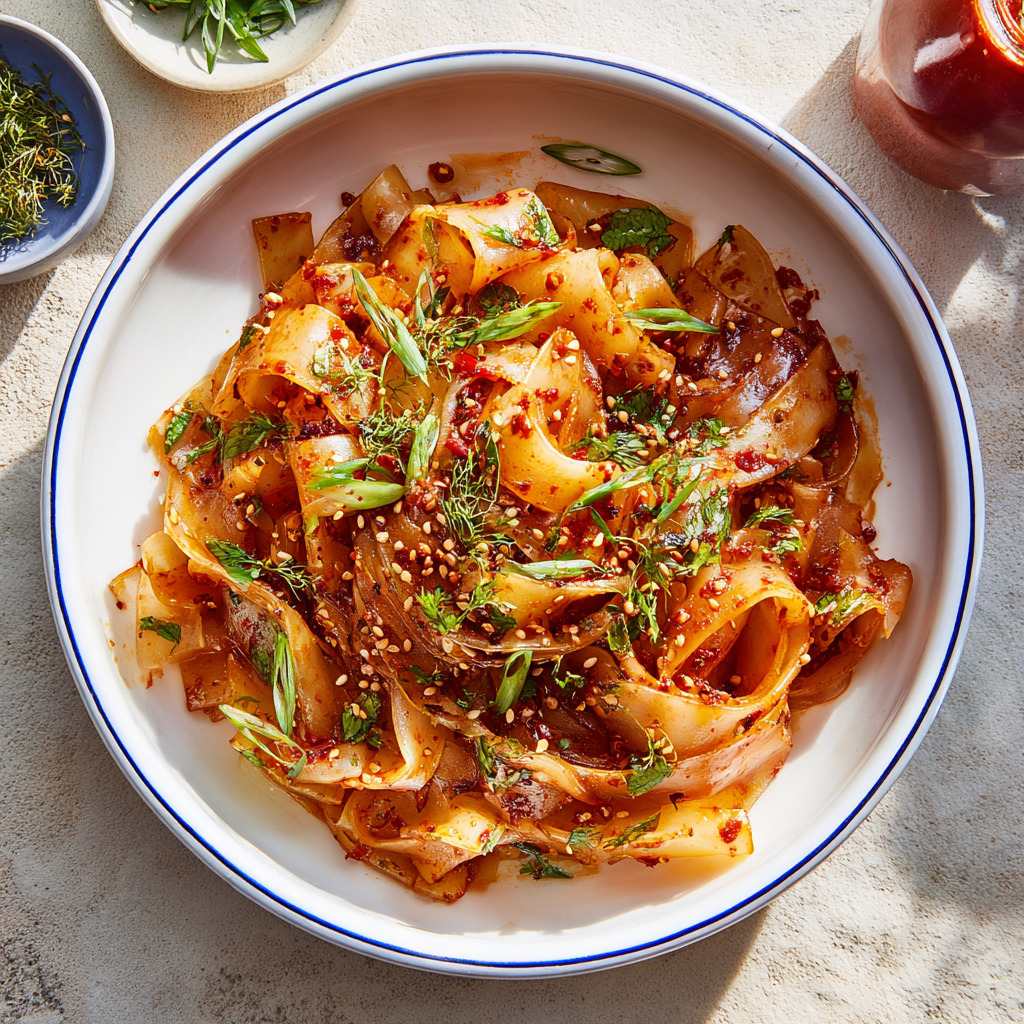These Spicy Rice Paper Noodles are chewy, glossy, and coated in a sizzling chili oil sauce bursting with umami.
Made from rice paper sheets and tossed in a garlicky, gochujang-infused dressing, this quick and vibrant dish is perfect for a spicy noodle fix without boiling a single pot of water.
A flavor-packed vegan snack or side that feels totally gourmet!
Why You’ll Love This Recipe
Chewy and fun – Homemade noodles with a unique texture using rice paper sheets.
Fiery chili oil flavor – Red chili flakes, garlic, and gochujang bring deep, bold heat.
No boiling required – Hydrate rice paper in warm water—easy and mess-free.
Customizable – Adjust spice, add toppings, or use broth for extra richness.
Vegan-friendly – Naturally plant-based and full of flavor.
What You’ll Need (Ingredient Highlights)
Rice paper – The secret noodle base—hydrated and sliced into chewy strips.
Avocado oil – Neutral and heat-safe for pouring over the chili mixture.
Red chili flakes – Brings the heat when bloomed in hot oil.
Garlic & green onion – Fragrant aromatics that flavor the oil and sauce.
Gochujang – A Korean chili paste that adds deep, fermented umami flavor.
Soy sauce & sugar – Balance saltiness and slight sweetness.
Sesame seeds – Toasty, nutty crunch to finish the dish.
Warm water or chicken broth – Helps thin out the sauce and carry flavor into the noodles.
Fresh cilantro – A bright, cooling garnish to offset the heat.
Pro Tips Before You Start
Stack rice paper evenly – Align perfectly to ensure even texture when slicing.
Brush with oil while softening – Prevents sticking and tearing once cut.
Use hot, shimmering oil – Pour carefully over the chili mixture to bloom flavors.
Toss noodles right before serving – Keeps them chewy and perfectly coated.
Taste and tweak – Adjust salt, heat, or gochujang for your perfect balance.

How to Make Spicy Rice Paper Noodles
Step 1: Prep the Rice Paper Noodles
Dip 2 to 3 sheets of rice paper in warm water and stack them evenly.
Lay on a cutting board and let them soften.
Brush both sides with oil to prevent sticking.
Slice into 1-inch wide noodles and transfer to a bowl of cold water to keep hydrated.
Repeat with remaining sheets.
Step 2: Build the Chili Base
In a mixing bowl, add red chili flakes, minced garlic, green onion, sesame seeds, sugar, and gochujang.
Set this aside while you heat the oil.
Step 3: Heat the Oil
Warm 2 to 3 tablespoons of avocado oil in a small pan over medium-high heat until shimmering.
Carefully pour the hot oil over the chili bowl—it should sizzle and become fragrant.
Step 4: Add Liquid Seasoning
Stir soy sauce, warm water (or chicken broth), and a pinch of salt into the chili oil mixture.
Whisk until well combined.
Step 5: Toss the Noodles
Drain the sliced rice paper noodles from the cold water.
Add them to the sauce bowl and toss until evenly coated and glossy.
Step 6: Garnish and Serve
Top with freshly chopped cilantro and serve immediately while warm and fragrant.
What to Serve It With
Crispy tofu or tempeh – Adds protein and crunch.
Cucumber salad – A cool, fresh contrast to the spicy heat.
Steamed dumplings – Serve on the side for a full Asian-inspired meal.
Iced green tea or Thai tea – Perfect for balancing the spice.
Variations / Substitutions
Make it gluten-free – Use tamari or coconut aminos instead of soy sauce.
Add protein – Toss in grilled shrimp, chicken, or crispy tofu.
Swap oils – Use sesame oil or neutral canola oil in place of avocado oil.
Adjust spice level – Reduce chili flakes or skip gochujang for a milder version.
Use broth for depth – Swap water with chicken or veggie broth for extra savory flavor.
Storage & Leftovers
Best eaten fresh – The texture of the rice paper noodles is ideal right after tossing.
Short-term storage – If needed, store in the fridge for up to 1 day.
Refresh with a splash of warm broth or oil before serving.
Do not freeze – Rice paper noodles become too soft and sticky when frozen and thawed.
Store sauce separately – For make-ahead prep, keep noodles and sauce apart until serving.
FAQs
Can I make the noodles ahead of time?
Yes, but keep them in cold water and assemble just before serving for best texture.
What if my rice paper sticks?
Brushing both sides with oil prevents sticking—don’t skip this step.
Is this recipe very spicy?
It’s medium-hot. You can reduce chili flakes or gochujang for a milder flavor.
Can I use pre-made chili oil instead?
Yes! Just skip the oil-heating step and mix with the rest of the sauce ingredients.
Is there a substitute for gochujang?
You can use chili garlic sauce or sambal oelek, though the flavor will be different.
Can I use square rice paper?
Yes, square or round works—just trim edges if needed to stack evenly.
Can I double the recipe?
Absolutely. Scale up the sauce and prep more rice paper as needed.

Final Thoughts
These Spicy Rice Paper Noodles are one of the most creative and satisfying dishes I’ve made with pantry staples.
The chewy texture, sizzling chili oil, and gochujang punch make every bite exciting and bold.
It’s a fun, fiery twist on noodles—perfect for adventurous eaters or anyone craving something totally different and full of flavor!

Spicy Rice Paper “Noodles”
Ingredients
For the Noodles:
- 8 sheets rice paper
- 2 –3 tablespoons avocado oil
- ½ tablespoon red chili flakes
- 1 small garlic clove minced
- 1 tablespoon chopped green onion
- 1 tablespoon sesame seeds
- 1 teaspoon sugar
- 1 tablespoon gochujang
- 2 tablespoons soy sauce
- 3 tablespoons warm water or chicken broth
- Pinch of salt to taste
For Garnish:
- Chopped fresh cilantro
Instructions
- Dip 2–3 rice paper sheets in warm water, stack evenly, and let soften.
- Brush both sides with oil. Slice into 1-inch noodles. Place in cold water. Repeat.
- In a bowl, combine chili flakes, garlic, green onion, sesame seeds, sugar, and gochujang.
- Heat avocado oil until shimmering. Carefully pour over chili mixture.
- Stir in soy sauce, warm water or broth, and salt. Mix well.
- Drain noodles and toss in sauce until coated.
- See full steps with tips & photos → https://wimpysdiner.net/spicy-rice-paper-noodles/
Notes
- Rice Paper Brands: Look for the thinner, Vietnamese-style wrappers for more tender “noodles.”
- Prevent Clumping: Keep the cut noodles in cold water until just before tossing; drain very well to avoid watering down the sauce.


